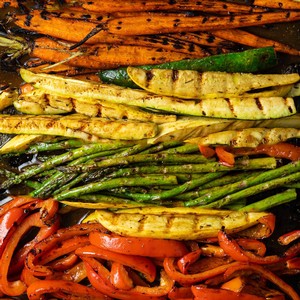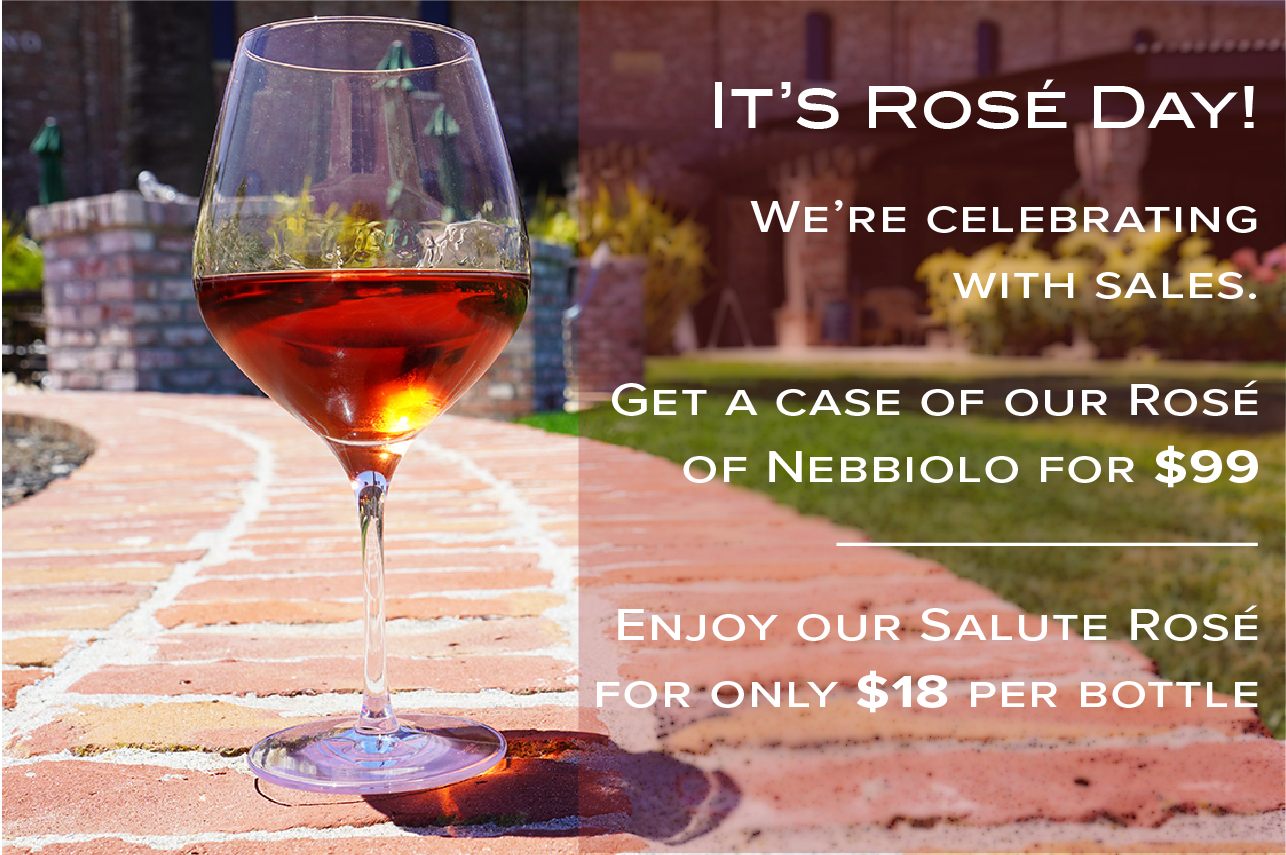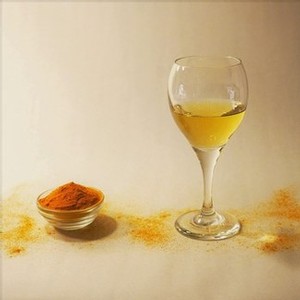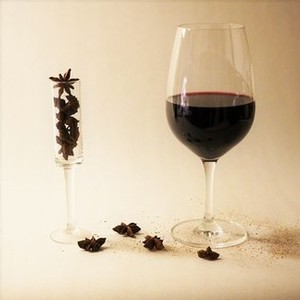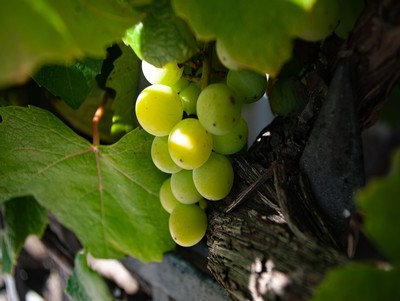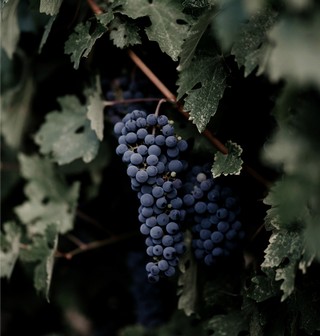A Taste of Winemaking History in the USA
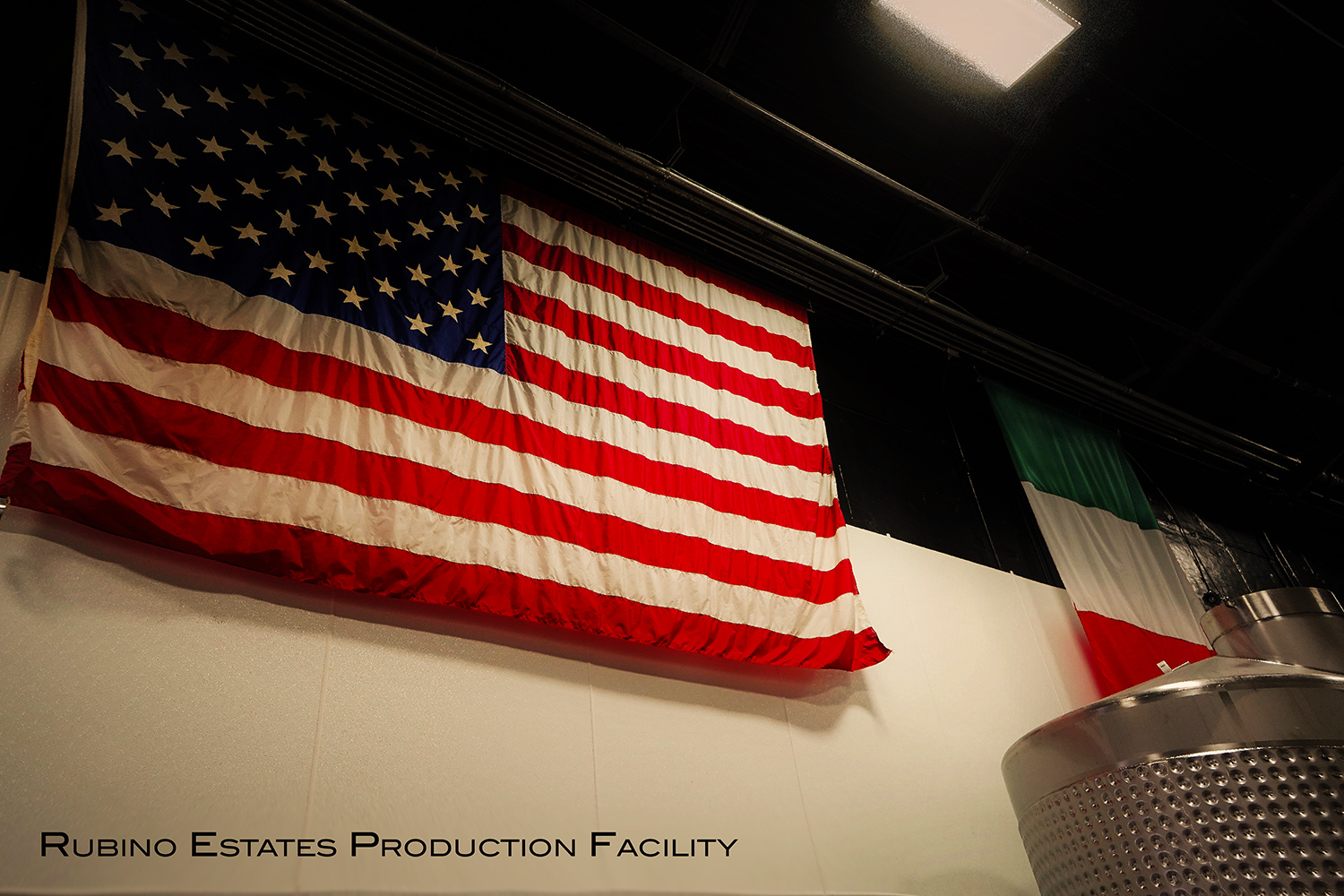 This weekend is our time to celebrate the United States! Nowadays, every U.S. state (yes, even Alaska) produces wine, but that wasn’t always the case. Just like this country, winemaking in the US has come a long way from humble and difficult beginnings, with plenty of mistakes along the way. Today, we’re taking time to look back and celebrate progress!
This weekend is our time to celebrate the United States! Nowadays, every U.S. state (yes, even Alaska) produces wine, but that wasn’t always the case. Just like this country, winemaking in the US has come a long way from humble and difficult beginnings, with plenty of mistakes along the way. Today, we’re taking time to look back and celebrate progress!
The first wines in America were made in the 16th century with native grapes, in an area near modern-day Jacksonville, Florida. In the charters held by European settlers, winemaking was listed as one of the goals of their venture. When they found the native grapes unpleasant to their palate, Europeans eventually began bringing cuttings from their favorite wine grapes across the Atlantic. In the same era, Spanish settlers in what is now California and New Mexico began planting vineyards as they built Missions, a heritage which continues today with California’s robust wine country.
After the United States was established, Thomas Jefferson attempted to plant a vineyard with French grapes, but the vines could not hold up in the North American climate. In 1805, two small oak casks of wine were brought to President Jefferson from a new winery in Kentucky, but the winery’s vines soon suffered a similar fate. Winemakers in the early United States were met with continual opposition from the North American climate and pests, which European grapes could not sustain. It was not until traditional French grapes were crossed with grapes native to the Americas that the U.S. saw its first widespread commercial plantings.
Cincinnati, Ohio was the home of the first majorly successful wineries in the United States, beginning in the early 1800s. Helped by the labor of German immigrants and the soil of the Ohio River Valley, the wineries boasted at least 1500 acres of vines. These plantings produced until Black rot swept through, decimating the plantings. To escape the rot, several winemakers moved their operations to the now-famous Finger Lakes region of New York. The oldest continually operating winery in the U.S. is Brotherhood Winery in New York, established in 1839, only 45 years before the first plantings on our Estate.
Prohibition began nationwide in 1920 when the 18th amendment was ratified, and put a severe dent in the U.S.’s place in the wine market. Limited production of wine was permitted for sacramental use, allowing the monks and nuns of Mission wineries to preserve some of the grape varieties people loved. Of course, bootleggers also helped sustain the industry, transporting and selling alcohol illegally. At the time, our Estate winery was permitted to operate to produce sacramental wines, but Ernest Ferrario, the owner at the time, was widely rumored to also be a bootlegger.
Prohibition was repealed in 1933, shortly after the global GDP had dropped at least 15% in the beginning of what is now called the Great Depression. Demand for heavy, sweet wines with high alcohol content increased, and the American wine industry struggled to dust itself off and keep up with demand. As time passed and research into winemaking was performed by premier academic institutions, most notably California’s UC Davis, US winemaking grew in both quality and efficiency.
The 1970s saw a flood of investments into American (especially Californian) wineries as winemakers focused on making wine the best it could be. No longer would they aim to produce a copy of European wine, but rather unique, brilliant representations of what the US could offer. The Judgement of Paris—a blind tasting in 1976 which resulted in two Californian wines beating out traditional European wines—solidified the foothold of American wine in the global market. Robust, thrilling, and exuberant, the wines of the USA could compete with wines from all around the world. They still do. Today, upwards of 1.1 million acres of vines grow in the US, with a production of at least 800 million gallons of wine each year. We're honored to join in this rich legacy and tradition.
What You Should Know About Chardonnay
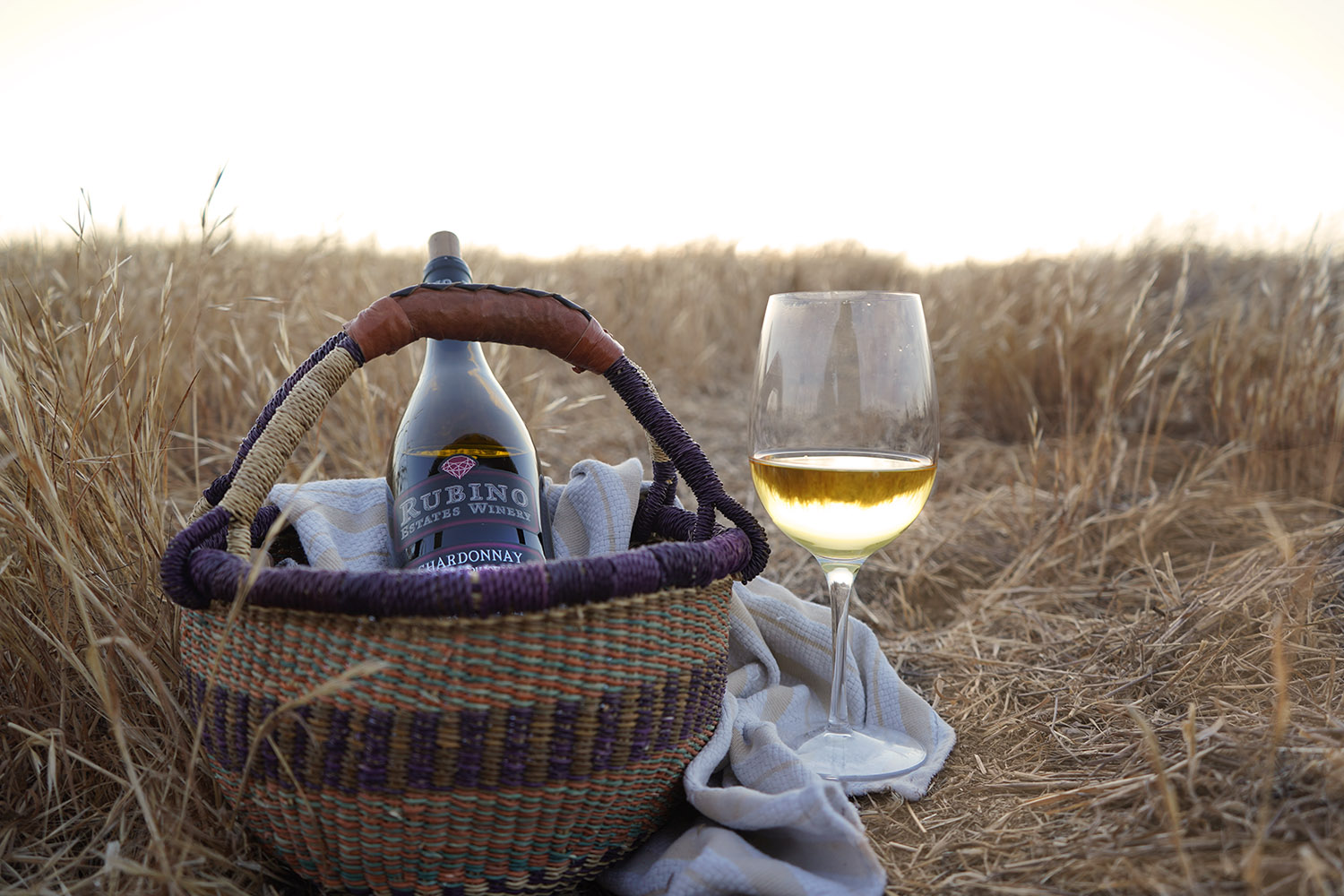 For all of June, we’ve been appreciating our Riserva Chardonnay, which was crowned our ''Wine of the Month.” As one of the most widely known and recognized white wine varietals, Chardonnay has earned its fame from its approachability and golden splendor. Some sommeliers consider the quality of an establishment’s Chardonnay to be a metric for guessing the quality of the winery as a whole. Despite its popularity, there’s a few things you might not know about Chardonnay—so read on!
For all of June, we’ve been appreciating our Riserva Chardonnay, which was crowned our ''Wine of the Month.” As one of the most widely known and recognized white wine varietals, Chardonnay has earned its fame from its approachability and golden splendor. Some sommeliers consider the quality of an establishment’s Chardonnay to be a metric for guessing the quality of the winery as a whole. Despite its popularity, there’s a few things you might not know about Chardonnay—so read on!
The Old World. The Illustrious history of Chardonnay dates back at least as far as the Roman empire, when vines of a varietal called Gouais Blanc were brought from Croatia to mainland Europe. Gouais Blanc would eventually cross-pollinate with the French Aristocracy’s Pinot Noir, creating a robust descendant. The gorgeous golden-green of Chardonnay grapes was born from these vines. For many years, Chardonnay was grown alongside, blended with, and mistaken for pinot blanc. Chardonnay would not gain its own fame until later, partially aided by the particular use of Chardonnay in Champagne.
Californian Perfection. “New World” Chardonnay has a life of its own, with some of the best Chardonnay in the world growing in California. The first successful planting of Chardonnay grapes in California was right here in the Livermore Valley, and we’re proud to continue that legacy. Chardonnay thrives in California’s valleys, where blankets of coastal fog slow the ripening of the grapes and encourage flavorful, robust fruit. Californian Chardonnay exploded in popularity after the “Judgement of Paris” in 1976, where multiple Californian wines, including a Chardonnay, beat French wines in a blind tasting.
Global Spread. Though Chardonnay is now considered the most famous of the white wines, it comes in 6th place in terms of global acreage with around 520,000 total acres. It also comes in second place in terms of acreage for white wines, beat out by the Italian varietal Aivén. As far as global spread is concerned, however, Chardonnay is the winning vine. Virtually anywhere wine is grown, there is Chardonnay.
Person and Place. The widespread cultivation of Chardonnay makes for huge variety in what the wines can offer. It is referred to as “malleable” meaning that the taste of the wine is highly dependent on the style and work of the Winemaker, as well as terroir—the unique conditions of the place in which it was grown. When you sip a Chardonnay, some say you “taste the place.” The Winemaking process lends significant flair as well. A natural process called “malolactic fermentation” is used on some Chardonnay to create a smooth, buttery, and less acidic wine.
Cream and Spice. The use of oak barrels is the source of most of the Winemaker’s influence when crafting a Chardonnay. Some Chardonnays are fermented and aged in stainless steel, though oak lends iconic flavor and complexity. Sometimes referred to as the Winemaker’s spice rack, oak barrels, when used either for aging or for both fermentation and aging, can impart toasty flavors of vanilla, caramel, spice, cream, coconut, cinnamon, cloves, and more. After bottling, Chardonnay is delicious when young while still holding up well if aged.
If you think you don't like Chardonnay, don't give up on it! Don't be afraid to give it another try--likely, you just haven't found the right one for you. There's a bottle out there that's perfect for your palate and preferences.
If you're a fan of our critically-acclaimed Riserva Chardonnay, don't miss your chance on our Wine of the Month sale!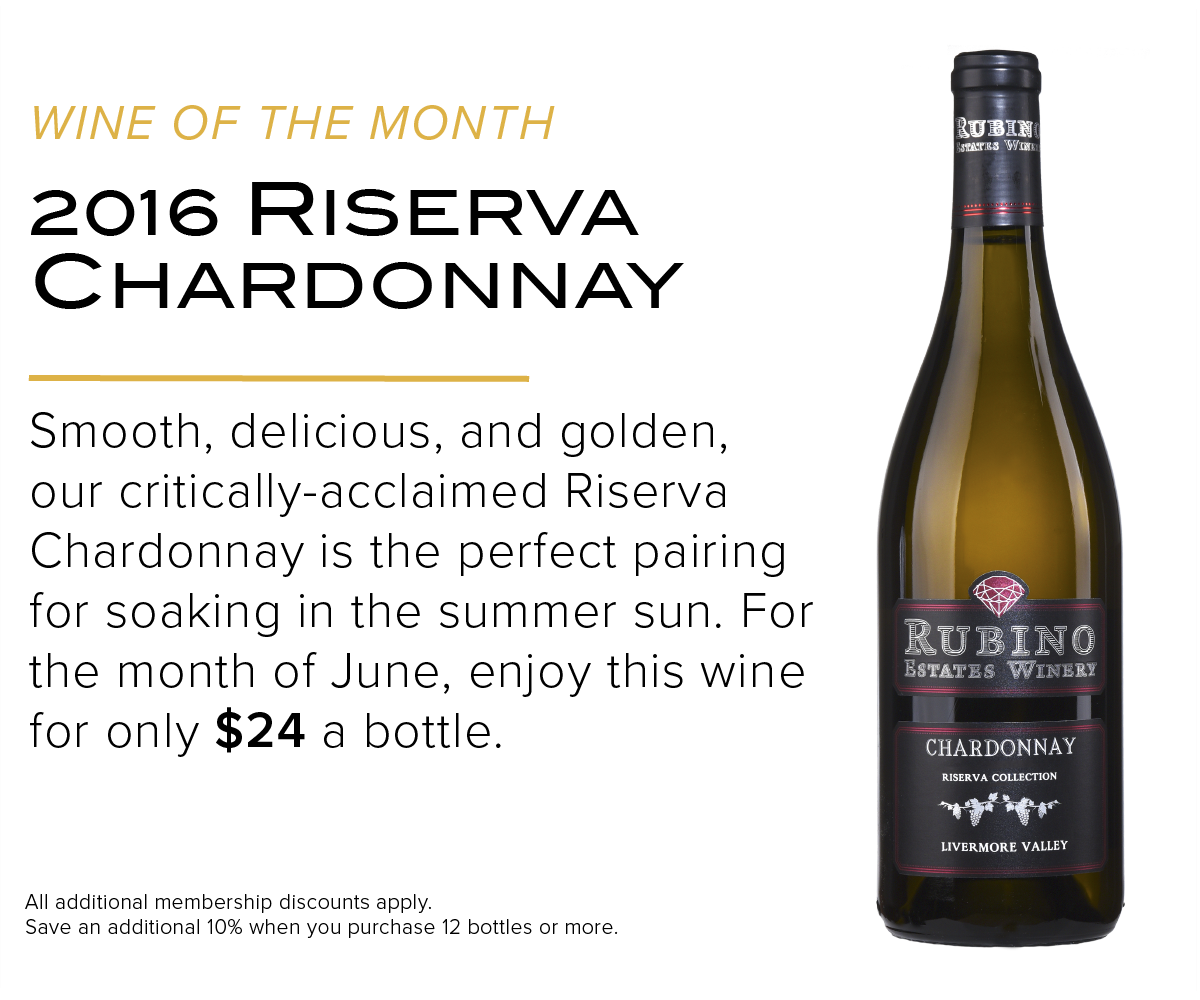
Why You Should Bring Sparkling Wine to a Cookout
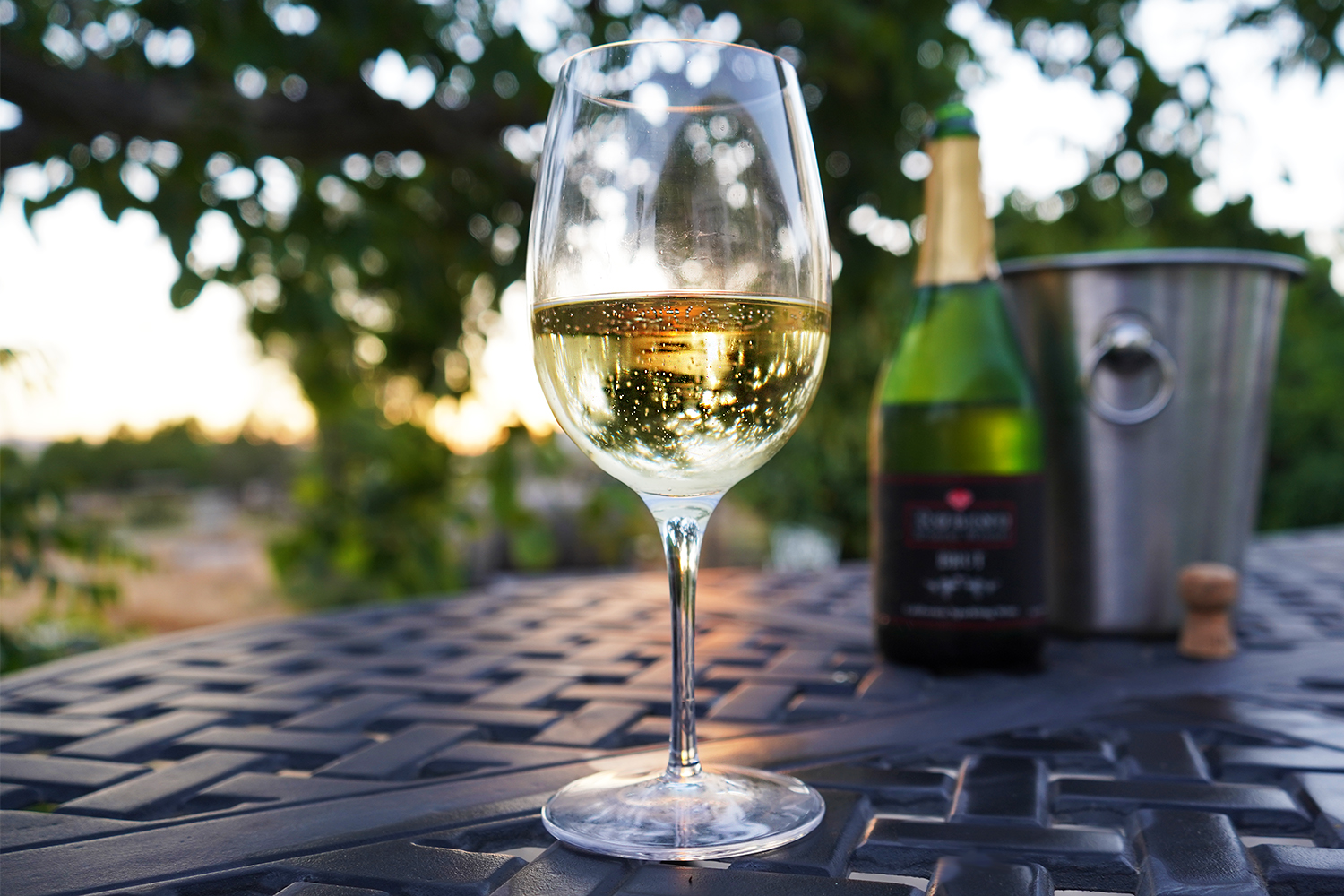
Marinated Grilled Vegetables - A Spicy Perspective
Our parents were right--we’re better off if we eat our veggies. In this case, we’re popping them in a marinade so they offer a burst of flavor as well as color to our smorgasbord. Feel free to play with the flavors, and don’t forget to take a picture of the perfect char marks.
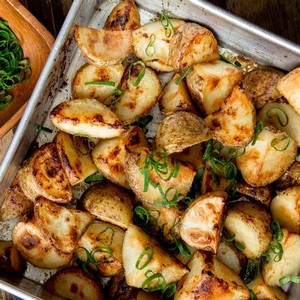
Honey Miso Garlic Roasted Potatoes - Pups With Chopsticks
If you’re looking for an elevated substitute for potato salad, look no further than these grilled potatoes. A symphony of umami, sweet, and salty, this recipe promises perfect texture and toothsome taste, perfect for before and after a sip of sparkling wine.
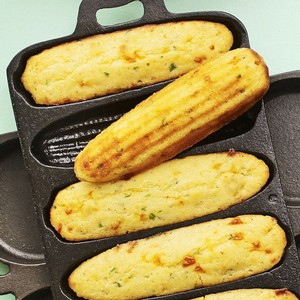
Cheesy Scallion Cornbread - Charlyne Mattox for Country Living
Nothing tastes quite as deliciously authentic as hot cornbread cooked in cast iron. Whether you have a cornbread pan or just a standard cast iron skillet, this classic is a must-have for your cookout. The scallions add a perfect touch of color and the cheese takes this from tasty to drop-dead delicious–and perfect for pairing.
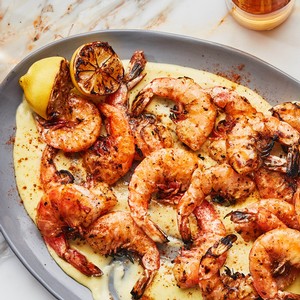
Grilled Shrimp with Old Bay and Aioli - Molly Baz for Bon Appetit
It's hard to beat the smoky, savory profile of grilled shrimp, accented perfectly in this dish by charred lemons and homemade aioli. A little topping of Old Bay seasoning will transport your taste buds to a seaside celebration. Chase it with a sip of bubbly, and you’re in for a good night.
Hopefully, we’ve given all the inspiration you need for an evening of grilling and sweet celebration. If you’re interested in some Sparkling Wine to go along with your dinner, it’s the perfect time to take advantage of our Dads & Grads sparkling sale, available this weekend only!
How to Choose the Right Rosé
 June 12th is Rosé day! This holiday falls on the Second Saturday of June each year, and we're big fans! Rosé wine is on the ascendance, and with good reason. Rosé can be just as sophisticated and refined as red and white wines, with astonishing variety and delicious complexity. Whether you prefer bold or delicate, aromatic or fruit-forward, dry or sweet, there’s a blushing bottle with your name on it. Once you find one you like, another world is opened up to you.
June 12th is Rosé day! This holiday falls on the Second Saturday of June each year, and we're big fans! Rosé wine is on the ascendance, and with good reason. Rosé can be just as sophisticated and refined as red and white wines, with astonishing variety and delicious complexity. Whether you prefer bold or delicate, aromatic or fruit-forward, dry or sweet, there’s a blushing bottle with your name on it. Once you find one you like, another world is opened up to you.
Why is it pink?
There’s actually a couple possible answers! Though it's a popular assumption, rosé isn't made by mixing red and white wines together. It may seem counter-intuitive, but it is possible to make light wines—even white wines—out of purple grapes. The coloration of wine comes from the skins of the grapes, so if the skins are removed before pressing, the product has no red hue. Rosés are crafted from same grapes used in making red wines. In the most popular method, the winemaker leaves the juice in contact with the skins until the desired color is achieved, then strains off the skins. This is the case for both our Rosé of Nebbiolo (100% Nebbiolo) as well as our brand-new 2020 Salute Rosé (100% Sangiovese).
Why is it young?
Darker red wines take time to age and settle into their tannins. Rosé wines, in contrast, are made to capitalize on the delicate aromas and fresh, fruity flavors of their varietals. This is best captured by fermenting the wine at a lower temperature and bottling the wine sooner than other varieties, capturing the precious aromas. Don’t be afraid of a 2020 Rosé! The wine is ready to be enjoyed in all of its intricate flavors and structure.
Which Rosé is right for my palate?
Think about different Rosés the same way you would think about different red wines. Just like you can expect big differences between a Pinot Noir and a Petit Verdot, you can expect big differences between different types of Rosé.
To list a few of the classics: if you like Rosé with high, zesty acidity and fruity notes, go for a Grenache Rosé. For palates that prefer a pale, herbaceous, and savory profile, a Tempranillo Rosé is right for you. Syrah and Cabernet Rosés are full bodied and can often be served and paired like red wine, bearing similarities to their red counterparts without the complexities of oak aging. Zinfandel Rosé, also called White Zinfandel, is mildly sweet and best served very cold. US-grown Nebbiolo Rosé is hard to find, but it’s perfect if you’re looking for a medley of ripe fruit flavors with a light body and pleasantly balanced tartness. If you want a fruity Rosé with a sparkling, coppery color, bursting with fresh flavors without being too sweet, opt for a Sangiovese Rosé.
What flavors should I look for while tasting?
Most Rosé wines have rose petal aromas and pleasant minerality, though every varietal has its own expression. With our Salute Rosé, look for flavors characteristic of Sangiovese Rosé, namely strawberry, raspberry, wild cherry, watermelon, cranberry, and herbs. In our Nebbiolo Rose, on the other hand, search for flavors and aromas of wild strawberry, pomegranate, raspberry, grapefruit, violets, and white pepper.
Wine and Spice & Everything Nice
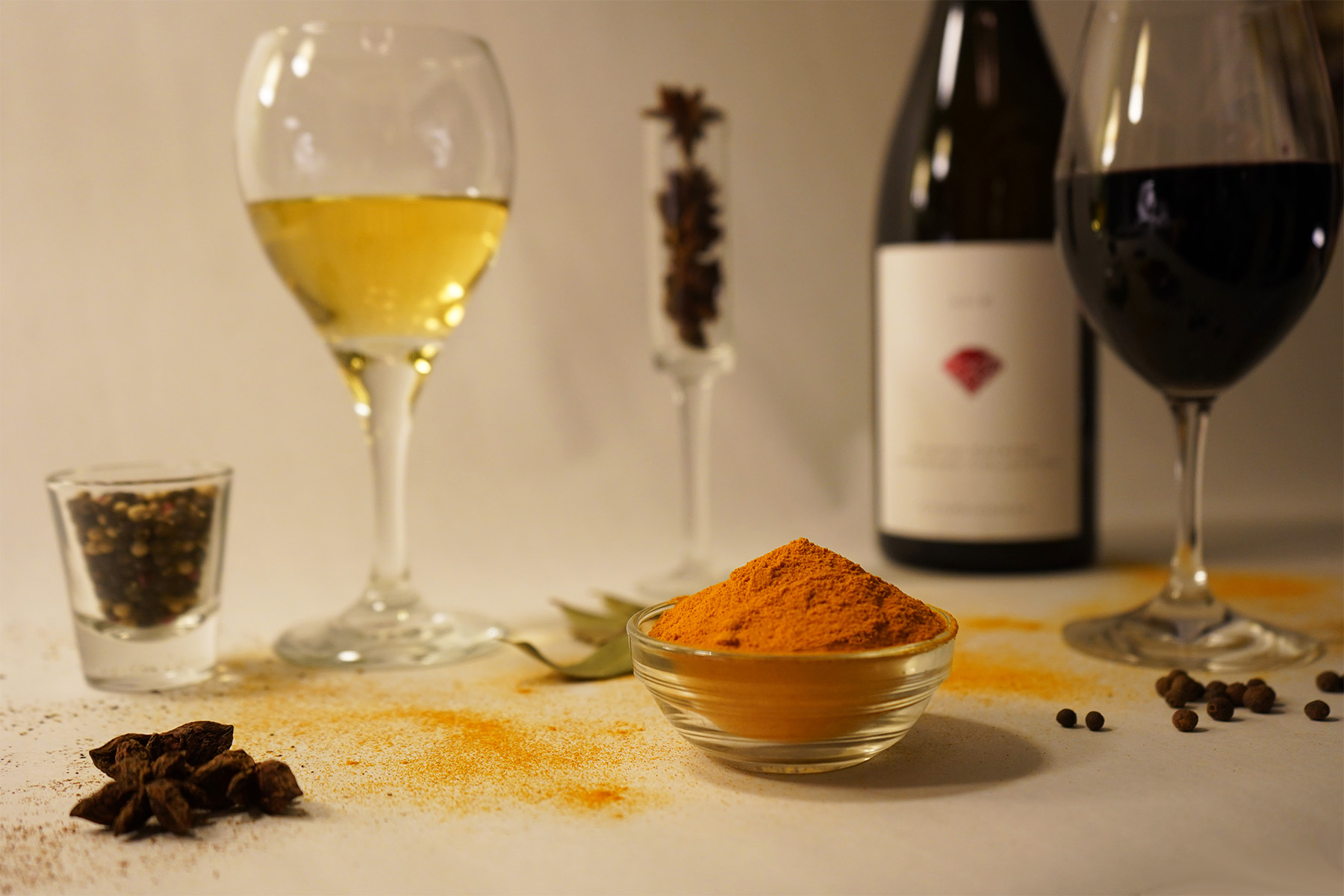
Chive - Trebbiano
Chives can be thought of as the subdued cousin of onion and garlic. The elegant umami flavor profile of this herb makes chives more than merely a beautiful garnish; they shine in fresh, light foods like omelets, deviled eggs, fish, and salads. These dishes pair deliciously with the creamy mouthfeel and light acidity of our Trebbiano.
Turmeric - Riserva Chardonnay
Dishes cooked with turmeric feature complex and pungent citrus-pepper notes appearing alongside the signature orange-yellow pigmented hue. Enjoy the flavorful, earthy profile with a glass of buttery-smooth and delightfully aromatic Riserva Chardonnay for a pairing that is good as gold.
Allspice - Landmark Pinot Noir
Similar in appearance to peppercorns, Allspice features warm scents of baking spice with a hint of pepper. Suitable for both sweet and savory applications, allspice smells like the holidays all year round. Notes of baking spice and golden crisp apple in our Landmark Pinot Noir make this couple terrifically toothsome.
Rosemary - Primitivo
Rosemary is a friend of wines, pairing well with a number of different reds and blends. Whether dried or fresh, it makes for a tasty and aromatic addition to savory dishes—whether it’s roasted potatoes, focaccia bread, or baked chicken. Enjoy these alongside the smooth body and oak-framed fruit notes of our Primitivo for a delicious combination.
Bay Leaf - Landmark Nebbiolo
Dried bay leaves are sturdy herbs known to infuse a subtle, almost tea-like, layer of complexity to dishes. Perfect for dishes that require some simmering time, bay leaves lighten up hearty dishes and provide a delicate accompaniment for the elegant aroma and full body of our Landmark Nebbiolo.
Black Pepper - Riserva Cabernet Sauvignon
What’s better with a glass of Cab than a medium-rare cast-iron seared steak? A pepper-crusted steak! It’s no coincidence; the characteristic tannins of Cabernet Sauvignon build a perfect flavor bridge that is highlighted by dishes with black pepper. Our Riserva Cab has layered, brooding aromas of dark fruit and hints of spice, perfect alongside fresh cracked black pepper.
Anise - Landmark Barbera
Star anise is beautiful and potent, steeping a sweet peppery licorice flavor into a wide range of savory dishes. Our Landmark Barbera features notes of star anise amidst its complex aroma, making it a stellar companion for anise dishes.
Careful pairings of wine and spices allow different, individual notes of the wine to shine through. It’s often the seasoning of the dish, rather than the dish itself, that makes a pairing palate-perfect, so feel free to experiment and expand this guide to make your food & wine harmonize better than ever!
A Taste of the Past
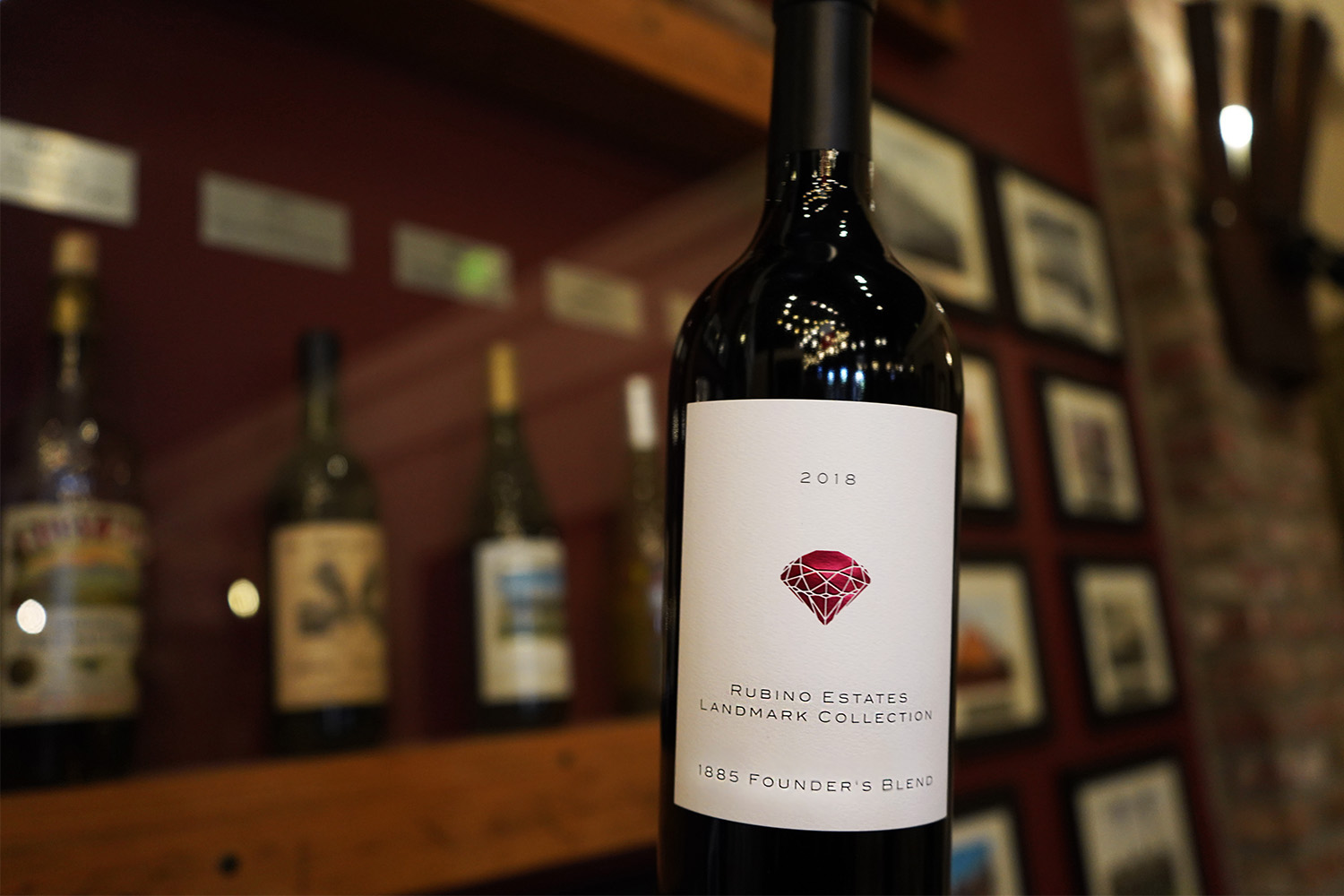
Presidents & Monuments
Early in 1885, incumbent President Chester A. Arthur dedicated the Washington Monument, which had taken nearly 40 years to complete due to funding, structural, and political issues. On March 4th of 1885, President Grover Cleveland was sworn in as the 22nd President (he would be elected again as the 24th President in 1892). In June of 1885, the French ship Isère arrived in New York Harbor, carrying the Statue of Liberty.
Entertainment & Pastimes
In 1885, Johannes Brahms’ phenomenal Symphony No. 4 premiered in Meiningen, Germany, with Brahms himself conducting it. In America, the first patent for a roller coaster was granted and Good Housekeeping magazine went on sale for the first time. P. T. Barnum split from his business partner, James Bailey, but continued his wildly popular Circus show.
Labor & Economy
After the gold rush, California was a place of relative wealth and growing population. In San Francisco, an average laborer could expect to make around $9 per week, while more specialized trades (like bookbinders and blacksmiths) made as much as $20 per week. A loaf of bread would cost about 7¢, while coffee cost an astonishing 30¢ per pound. In 1885, Charles Dow debuted the first edition of the Dow Jones Industrial Average. At the time, the index stood at a level of 62.76, representing the dollar average for stocks of 12 railroads and two leading American industries.
Inventions & Engineering
1885 was a monumental year for transportation. At that time, the train was king, but change was foreshadowed. That year the Daimler Reitwagen, regarded as the first modern motorcycle, was patented in Germany by Gottlieb Daimler and Wilhelm Maybach. Soon after, Karl Benz began production of the Benz Patent-Motorwagen, the first automobile, which was patented the following year. Meanwhile, in the US, the Home Insurance Building in Chicago was completed, becoming the first skyscraper in the world, boasting 10 floors and a fireproof metal frame.
Science & Medicine
Medical milestones in 1885 included the first successful treatment against rabies, which was considered a death sentence prior to this development. The rabies vaccine was developed in part by Louis Pasteur, the French scientist who invented pasteurization. Astronomers were also at work looking up into the stars. In 1885, they recorded the presence of a supernova, naming it S Andromedae, the first supernova to ever be identified outside of our own galaxy.
Food & Drink
In late 1885, Dr. Pepper was served for the first time, introduced in Waco, Texas by a pharmacist named Charles Alderton. Further West, California’s wine country was in its infancy. One New York based distributor included a small section in their wine price list for "California Wines" which ranged in price from 50-75 cents per bottle. Dessert wine from California was available in bulk for $1.50—per gallon (about 5 bottles).
It was into this world that John Crellin’s Estate vineyard grew. Today, Rubino Estates continues the legacy of viticulture, growing wine grapes in the Estate’s favorable climate and red clay soil. From our Founder in 1885 to present day, we are proud to continue this legacy. In honor of our Estate’s origin, we have proudly introduced a new wine to our Landmark Collection. Our Landmark 1885 Founder’s Blend is a delicious celebration of history and heritage.
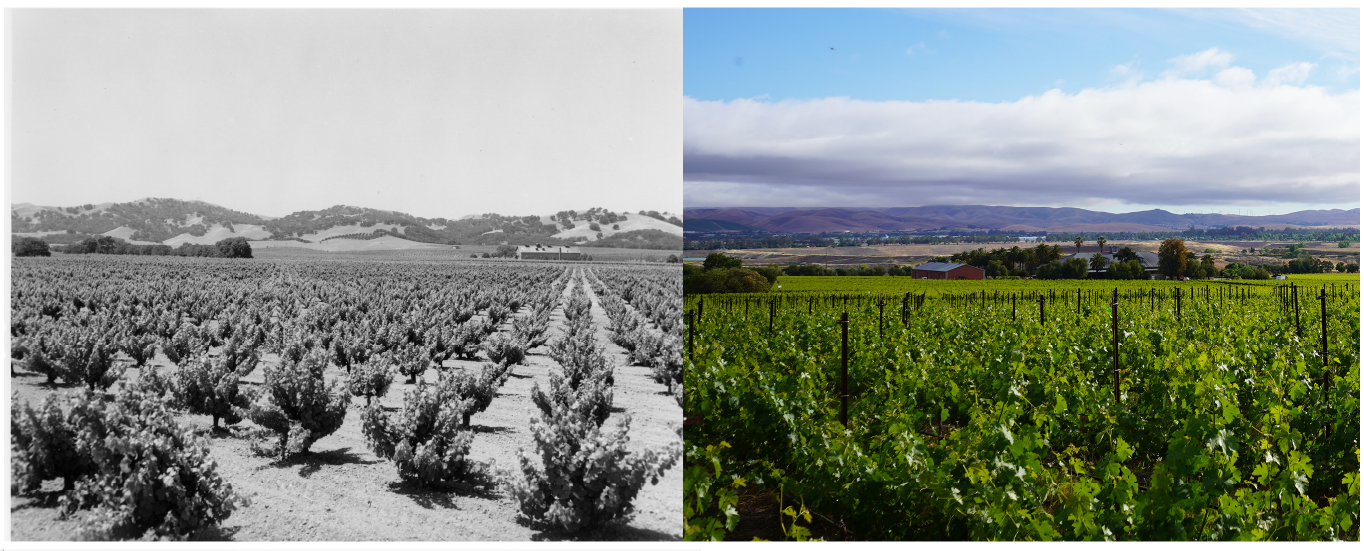
What to Eat with your May Release
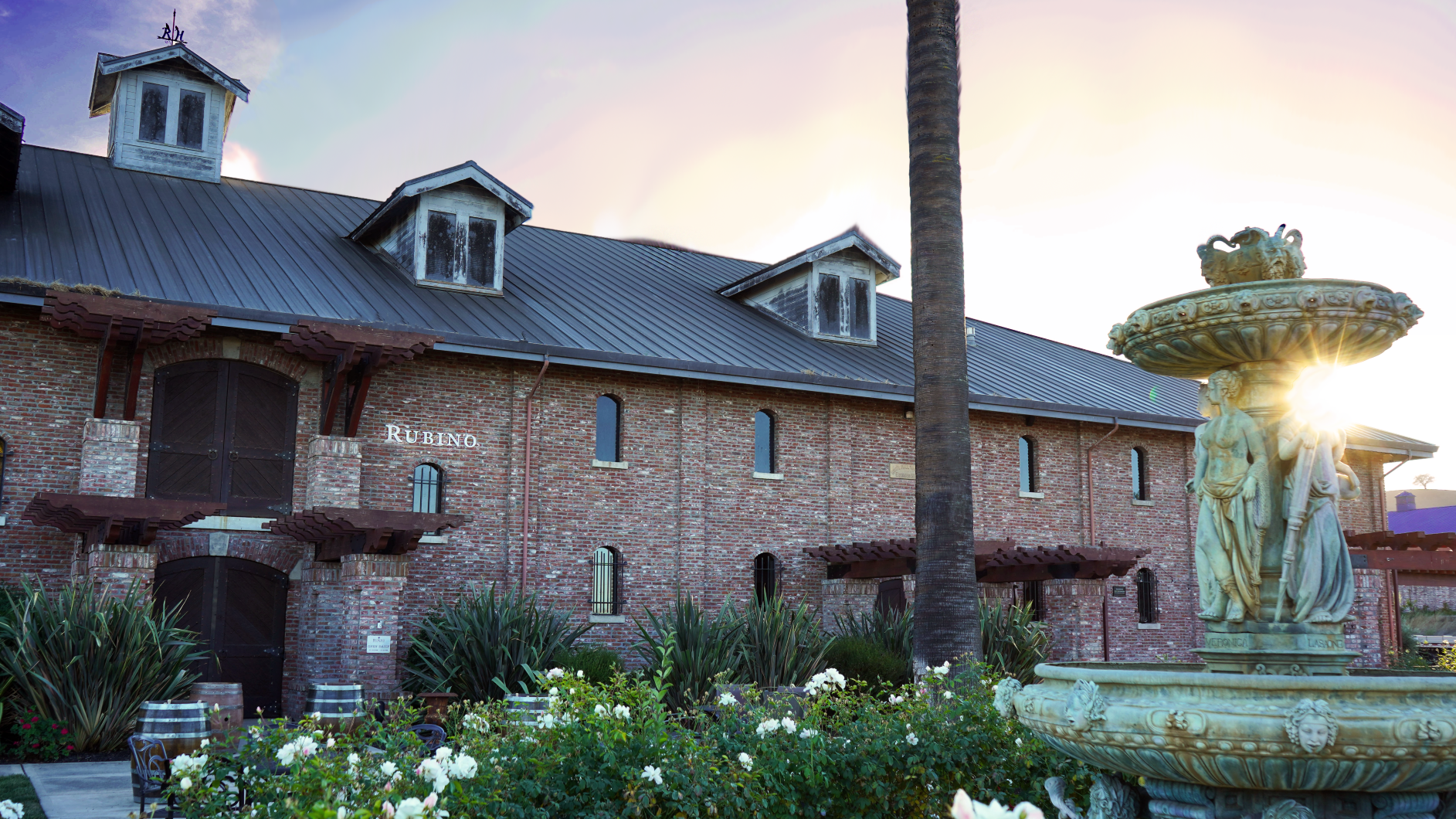 Starting this week, our members have to opportunity to pick up their wines from our May release, and we're so excited to share in the festive spirit. To celebrate, we've put together a few pairing ideas for all of our release wines. We've got starters, sides, and dessert, so it's time to open your favorite bottle and get cooking!
Starting this week, our members have to opportunity to pick up their wines from our May release, and we're so excited to share in the festive spirit. To celebrate, we've put together a few pairing ideas for all of our release wines. We've got starters, sides, and dessert, so it's time to open your favorite bottle and get cooking!
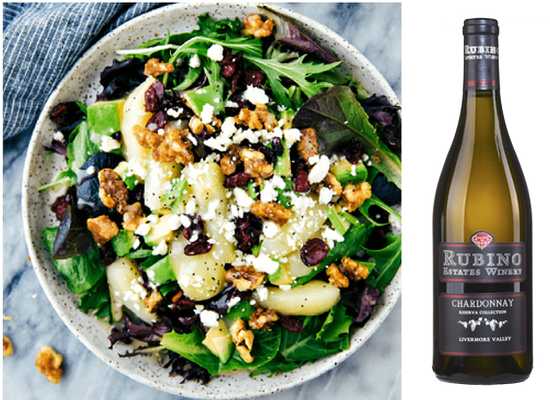
Riserva Chardonnay - Pear Salad with Candied Walnuts
This salad marries together a symphony of flavors and textures; the sweet crunch of the candied walnuts meets creamy diced avocado, tangy feta, and soft pears, topped with a simple lemon poppyseed dressing. Enjoy alongside the gorgeous aroma and rich body of our Riserva Chardonnay for a fresh and delicious pairing.
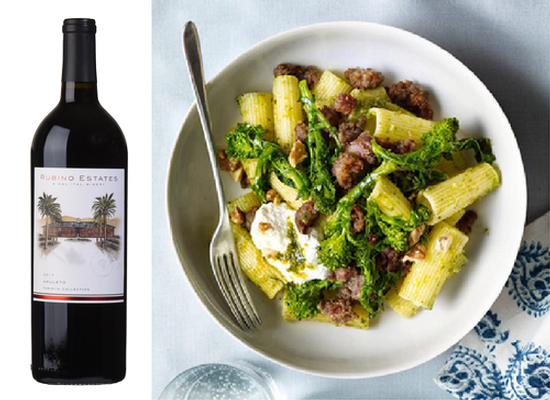
Amuleto - Pasta with Walnut Pesto, Sausage, and Broccoli Rabe
A simple but mouthwatering combination of fresh walnut pesto and Italian sausage joins broccoli rabe and tender rigatoni for a fresh and delicious dish. Served alongside our bright and expressive Famiglia Collection Amuleto, you’ll have a combination to crave. For an easy vegetarian alternative, remove the sausage or substitute it with squash seasoned with sage and caraway.
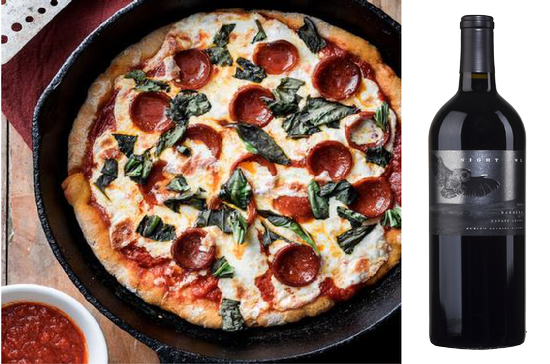
Night Owl Barbera - Smoked Pepperoni & Basil Pizza
It’s hard to say no to pizza, so we’re leaning into our specialty: Italian style. Our Night Owl Barbera has a full body and food-friendly acidity, making it perfect for all kinds of pairings. It’s right at home next to a homemade pizza! Add any toppings you like; today we’re going for smoked pepperoni and basil.
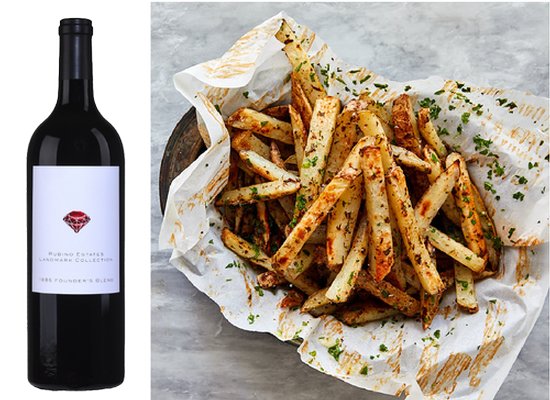
Landmark 1885 Founder's Blend - Homemade Truffle Fries
The 1885 Founder’s Blend is a brand-new addition to our Landmark collection, named in honor of the year 1885, when our original estate vineyard was planted by founder John Crellin. This 2018 red blend is smooth and rich with notes of dark fruit, making for a lovely pairing with the earthy and salty notes of homemade truffle fries.
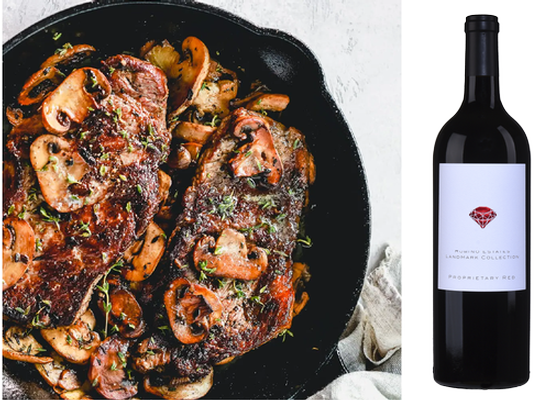
Landmark Proprietary Red - Pan Seared Steak with Mushrooms
Though the components of our Proprietary Red blend are a close-kept secret, it’s no secret that it pairs fabulously with pan-seared steak. Pull out your favorite cast-iron skillet and try a boneless ribeye or New York strip steaks in this surprisingly simple recipe. Savor your juicy steak and the savory earthiness of the mushrooms with a generous pour of our silky and inviting Proprietary Red.
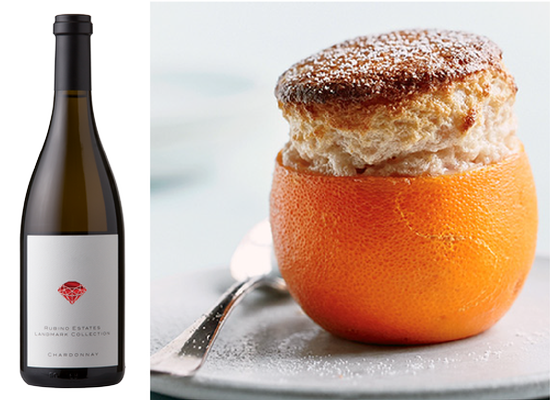
Landmark Chardonnay - Blood Orange Soufflé
These sweet tangy masterpieces are fluffy, warm, and classy—perfect for pairing with our Landmark Chardonnay. Enjoy sipping on exquisite honeyed aromas and stone fruit flavors infused with butterscotch, then bite into the fresh citrus warmth of these blood-orange souffles.
Happy release! Which pairing is your favorite? Let us know! @rubinoestates
If you're interested in becoming part of the Rubino Estaes Famiglia, click here to learn more about our Wine Club!
Italian Wine Varietals You Should Know
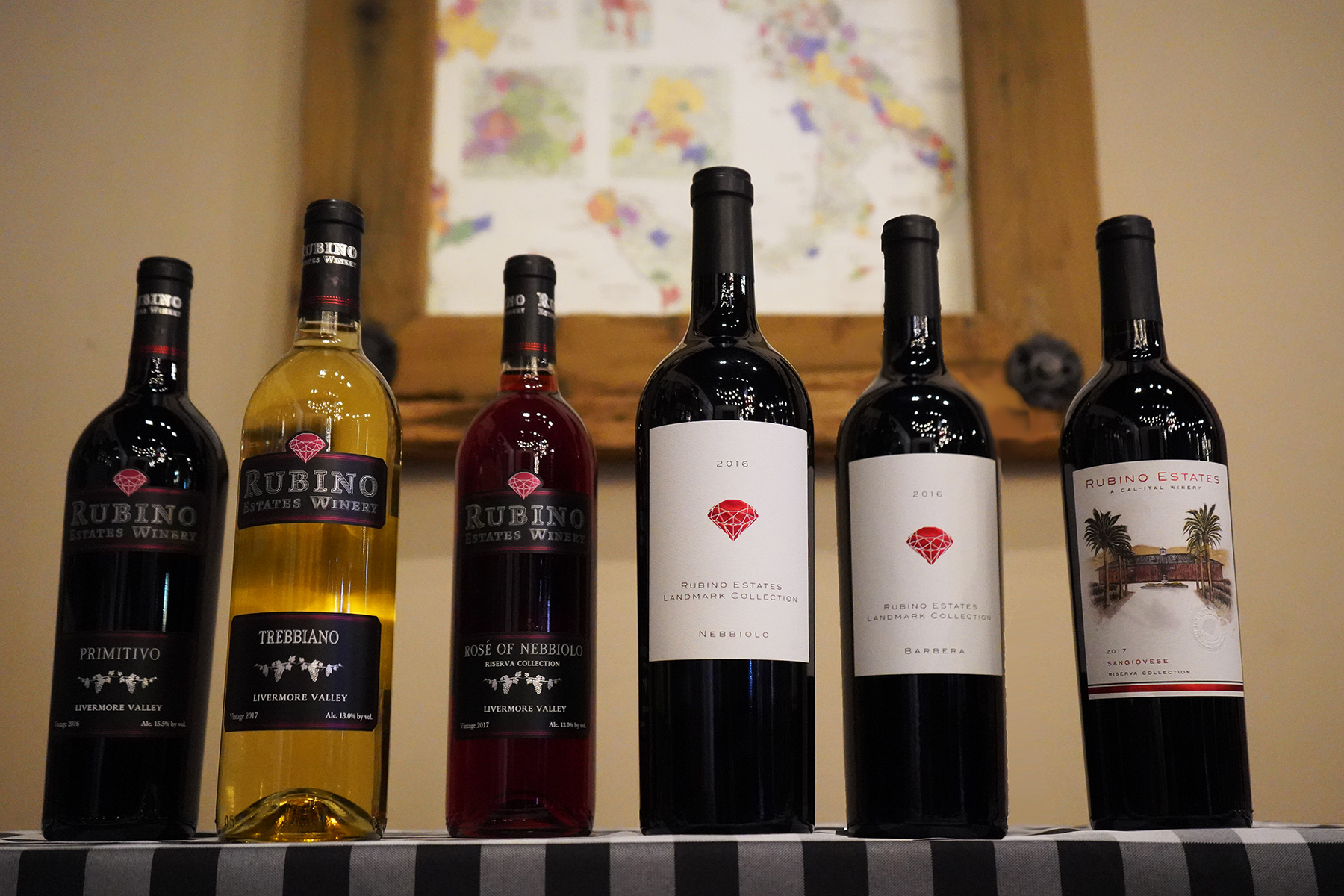
Trebbiano
Trebbiano grapes are a pale green, yielding wines that are light in color and on the palate. Refreshing, dry, and crisp, a glass of perfectly chilled Trebbiano is delectable on a summer day. Trebbiano supposedly originated in the eastern Mediterranean regions, making its way to Italy by the Roman times. This easygoing wine is perfect for pairing with all sorts of dishes, especially Mediterranean cuisine. In the US, Trebbiano is a rare find, but wines from the large Trebbiano family account for around one-third of Italy’s white wines.
Sangiovese
Sangiovese, often called by the nickname “Sangio” around here, grows prolifically in its home region of Tuscany. Sangiovese is featured in the famous “Super Tuscans” and Chianti Classico, and is the most planted varietal in Italy. In the US, it’s much harder to find. Italy boasts about 155,000 acres of Sangiovese vines—the most planted varietal in the county—while the US grows only 2,000 acres. This varietal’s deep purple grapes produce a gorgeous red color and cherry flavors, with intriguing flavor variation determined by the growing environment.
Primitivo
Primitivo is a curious varietal. Genetically, it is identical to Zinfandel, but Italian influence in the winemaking process differs this wine from its close relative. Originally from Croatia, Primitivo was first planted in Italy in the 1700s and now grows heartily in Puglia, the “heel” to Italy’s “boot.” Primitivo earned its name from the Latin word for “early ripening” since Primitivo grapes reach maturity sooner than similar varietals. Primitivo yields wines that are big, jammy, and rustic, perfect for pairing with classic Italian dishes.
Nebbiolo
Another lesser-known red varietal, Nebbiolo is grown almost exclusively in the Piedmont region of Italy. Historical records as far back as 1268 feature Nebbiolo as a prominent wine grape. The US grows as little as 170 total acres of Nebbiolo nationwide, so we are proud to offer this gem here at our Cal-Ital winery in the form of our Landmark Collection Nebbiolo as well as Rosé of Nebbiolo. The tannic nature of Nebbiolo grapes makes the wine ideal for aging, even holding steady for 20 years or more. The color is a pleasant red and surprisingly bright for being the yield of a purple-black grape.
Barbera
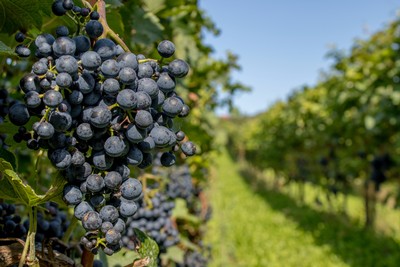
Here in the US, Barbera is one of the best-known Italian varietals, partially due to its vigorous and adaptable nature. Just like us, Barbera loves warm weather, which California has in abundance.This varietal’s prolific vines are known for easy drinking wines that are also worthy of savoring. Barbera grapes are a picturesque purple and yield medium-bodied, dry reds that are simultaneously fruity and savory. If you are looking for a reliable and versatile wine for food pairings, Barbera is the right red for you!
Now that you've got the background info, it's time for the fun part: tasting them! Our tasting room is open seven days a week so we're always here to raise a glass.
Did we miss your favorite varietal? Let us know on social media @rubinoestates!
Double-Chocolate Petite Sirah Cookies
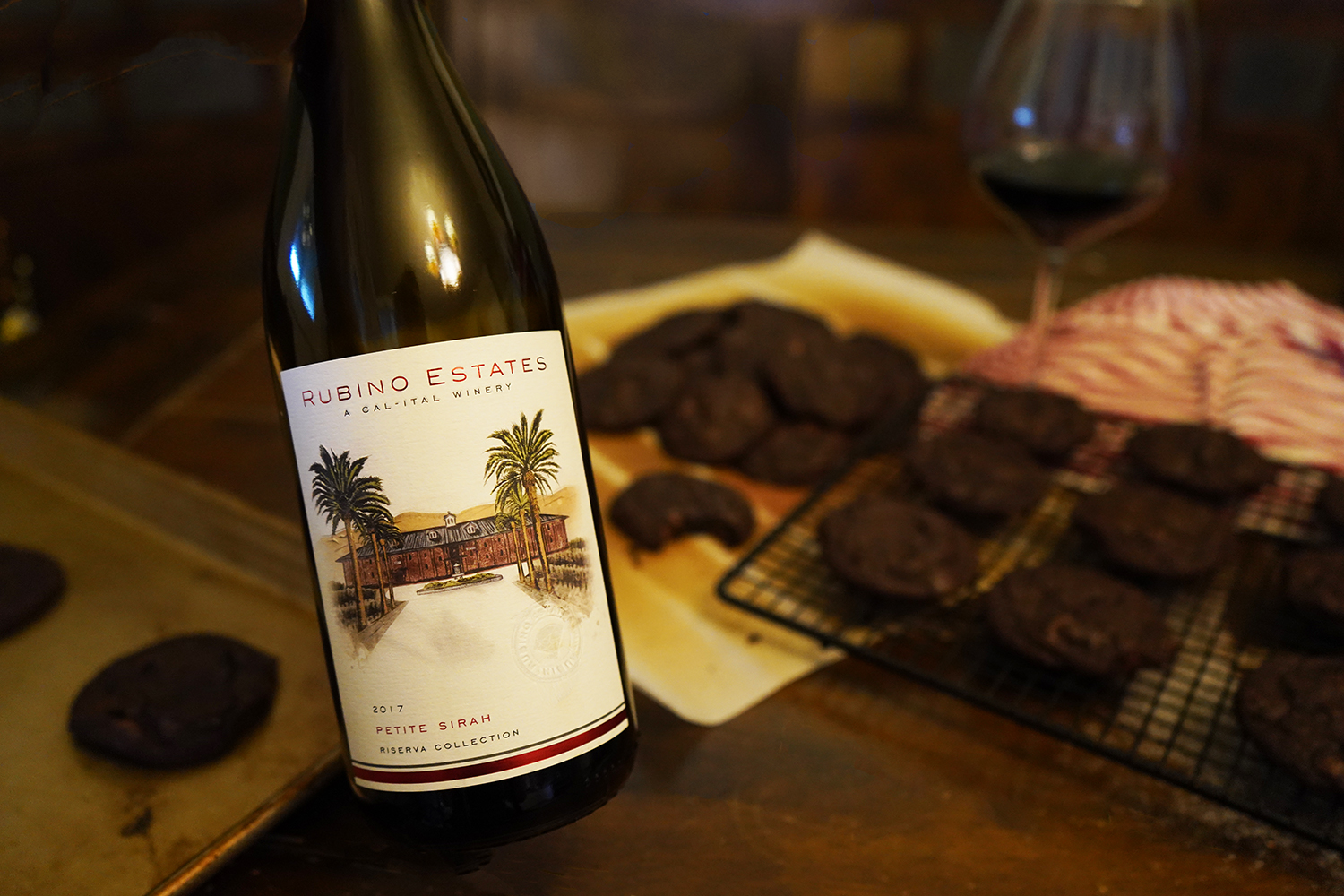
Double-Chocolate Riserva Cookies
- 1½ cups all-purpose flour
- ¾ cup cocoa powder
- 1 tsp salt
- 1 tsp baking soda
- ½ cup Irish butter
- ½ cup granulated cane sugar
- 1 cup light brown sugar, packed
- 1 large egg
- ½ tsp vanilla
- ½ cup Rubino Estates Riserva Petite Sirah
- 12 oz Guittard semisweet chocolate chips
- All ingredients should be at room temperature.
- In a medium-sized bowl, sift the flour, cocoa powder, salt, and baking soda together. Set aside.
- In the workbowl of a stand mixer, cream together the butter, granulated sugar, and brown sugar on medium speed. Scrape down the sides to ensure the ingredients combine.
- With the mixer turned off, add the egg, vanilla, and Petite Sirah. Combine on medium low until a smooth consistency is reached. At this point, your dough should be purple.
- We recommend pausing for a moment and pouring a separate glass and taking a sip. It makes the process better.
- Add the dry ingredient mixture in two increments, mixing to combine after each addition.
- Once the flour is combined, add the chocolate chips. Mix until the chocolate chips are distributed.
- Cover the dough and refrigerate for 30 minutes.
- When ready to bake, preheat oven to 375° F.
- Scoop rounded tablespoons onto a baking sheet lined with parchment paper, spaced at least 4 inches apart.
- Bake for 8-10 minutes, rotating halfway through to ensure even baking.
- Once removed from the oven, allow the cookies to cool on the pan for a few minutes, then transfer to a cooling rack.
Click here for a downloadable recipe card!
Serve fresh with the rest of your Petite Sirah! We don't want any wine going to waste, of course. These cookies are perfect anytime, not just with wine. Enjoy with your coffee in the morning or tea in the afternoon! They'll keep fresh in an airtight container for up to 3 days.
What's your favorite wine and dessert pairing? Let us know on social media @rubinoestates!
Things You Might Not Know about Cabernet Sauvignon
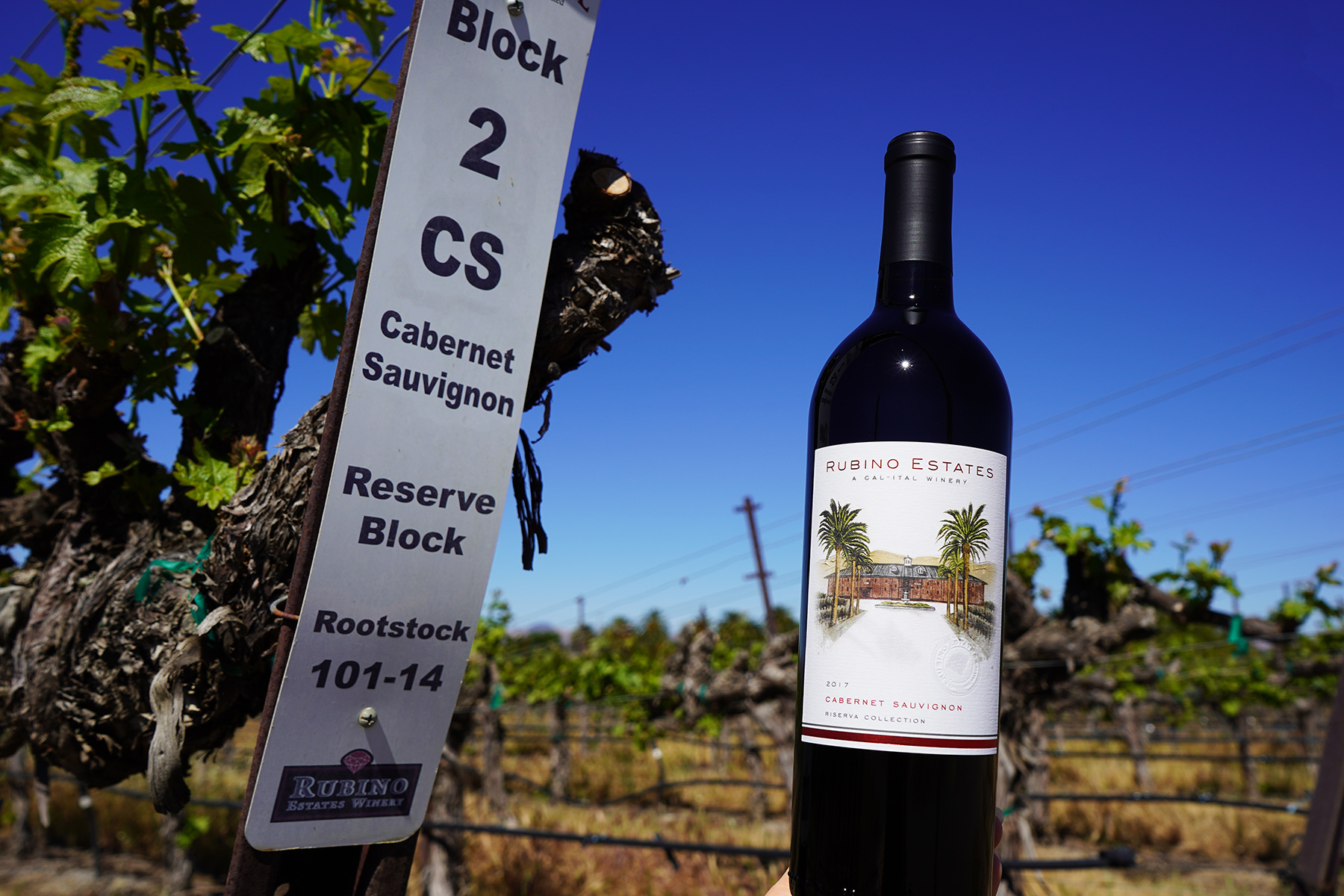
Cabernet Sauvignon is the most widely planted grape varietal in the world.
According to Forbes, there are at least 840,000 acres of Cabernet Sauvignon grapes planted worldwide. Though Cab has been increasing in popularity in its centuries of existence, it has experienced several surges in popularity. Between 1990 and 2010 alone, the worldwide acreage of Cabernet Sauvignon grapes doubled. Now, these grapes can be found growing on every continent except Antarctica.
Cabernet Sauvignon is like true love
Because it just gets better with age! Cabernet is known to increase in quality overtime in the cellar, and can even maintain quality over decades. This reliability is due to its tanninc nature. Not only are the tannins a delight to the palate, they ensure the enduring quality of the bottle if properly cellared. Cabernet Sauvignon earns this pleasant tannin character because the individual grapes are quite small and the skins are thick.
Cabernet Sauvignon is the star child of a famous family
The origins of this varietal were quite mysterious until a group of researchers at UC Davis discovered that it was the result of a (likely accidental) marriage of Sauvignon Blanc and Cabernet Franc vines. This romance was a surprise to many sommeliers who would not have correlated a delicate white wine like Sauvignon Blanc with such rich red offspring. Cabernet Sauvignon also shares a father with Merlot grapes, which are also offspring of Cabernet Franc.
Cabernet Sauvignon loves California
Just like us, Cabernet Sauvignon loves warm days as long as it gets some shade along the way. Cab ripens late and requires warmth to reach full ripeness. When Cabernet grapes are grown in cooler places, they generally exhibit notes of green pepper or eucalyptus, while warmer climate Cab is more fruit-forward. Both flavor profiles are sought after and are merely a matter of personal preference.
Cabernet Sauvignon is sometimes worth its weight in gold
Wine collectors and investors may regularly spend hundreds of dollars on rare or exclusive wines, and aged Cabernet Sauvignon is an excellent catch for a collector. The highest sale for any bottle of wine ever recorded was in 1992, when a 6 liter bottle of Cabernet Sauvignon sold at a charity auction for $500,000.
Cabernet Sauvignon is food's best friend
There's nothing quite like a marbeled ribeye, served perfectly medium rare with a glass of Cabernet Sauvignon. Many sommeliers agree that one of the best meats for this wine is actually lamb, best served roasted to medium wellness. Younger Cabs are specially suited to all kinds of richer meats due to the tannins that actually act as tastebud "scrapers," refreshing the palate between bites. As Cab ages, its tannins mellow out and integrate, broadening the pairing potential even further.
Cabernet Sauvignon helped a winemaking revolution
A delicious California Cabernet Sauvignon took center stage for one of the biggest upheavals in the modern history of wine. During the Paris Wine Tasting of 1976, a panel of French judges ranked California-grown Cabernet Sauvignon above French Cabernet Sauvignon in a blind tasting. Before that moment, wines grown in the native soil of the Bordeaux region were generally assumed to be the best in the world. Form then on, California's Cabernet Sauvignon could not be ignored. In the wine world, this historic tasting has become known as the “Judgment of Paris.”
Cabernet Sauvignon is a solo performer and a team player
In addition to tasting excellent as a standalone varietal, Cabernet provides an excellent backbone for a multitude of red blends. Most bordeaux-style blends owe some of their structure and flavor profile to the presence of this reliable grape. Many bottles of Cabernet also have a touch of another varietal; each winemaker adds their own personality and flair to the blend. As a Cal-Ital winery, we infuse a bit of Italian flair with just a touch of Barbera.
Here at Rubino Estates, we are proud to offer a California-Italian spin on this Bordeaux classic, recently awaraded a Double-Gold medal in the San Francisco Chronicle Wine Competition. Come by to give it a taste today, or place an order now!
